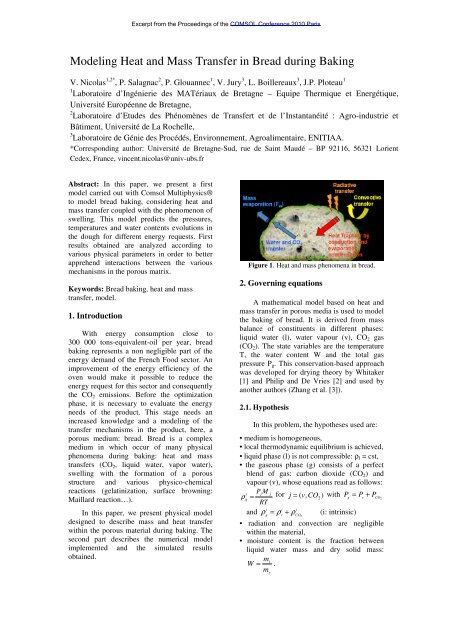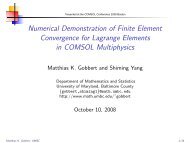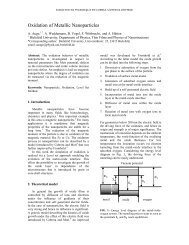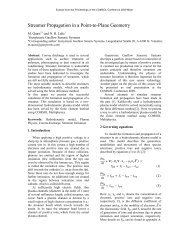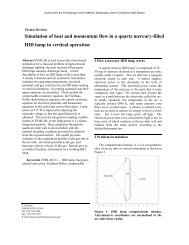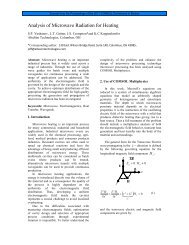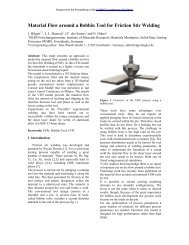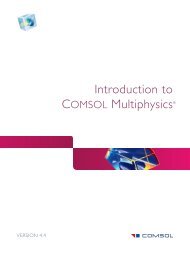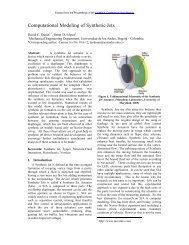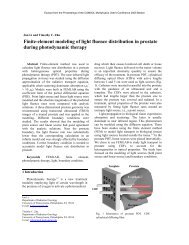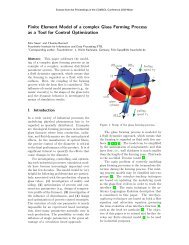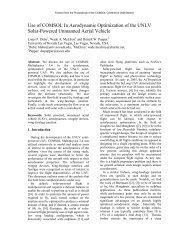Modeling Heat and Mass Transfer in Bread during ... - COMSOL.com
Modeling Heat and Mass Transfer in Bread during ... - COMSOL.com
Modeling Heat and Mass Transfer in Bread during ... - COMSOL.com
You also want an ePaper? Increase the reach of your titles
YUMPU automatically turns print PDFs into web optimized ePapers that Google loves.
Excerpt from the Proceed<strong>in</strong>gs of the <strong>COMSOL</strong> Conference 2010 Paris<br />
<strong>Model<strong>in</strong>g</strong> <strong>Heat</strong> <strong>and</strong> <strong>Mass</strong> <strong>Transfer</strong> <strong>in</strong> <strong>Bread</strong> dur<strong>in</strong>g Bak<strong>in</strong>g<br />
V. Nicolas 1,2* , P. Salagnac 2 , P. Glouannec 1 , V. Jury 3 , L. Boillereaux 3 , J.P. Ploteau 1<br />
1 Laboratoire d’Ingénierie des MATériaux de Bretagne – Equipe Thermique et Energétique,<br />
Université Européenne de Bretagne,<br />
2 Laboratoire d’Etudes des Phénomènes de <strong>Transfer</strong>t et de l’Instantanéité : Agro-<strong>in</strong>dustrie et<br />
Bâtiment, Université de La Rochelle,<br />
3 Laboratoire de Génie des Procédés, Environnement, Agroalimentaire, ENITIAA.<br />
*Correspond<strong>in</strong>g author: Université de Bretagne-Sud, rue de Sa<strong>in</strong>t Maudé – BP 92116, 56321 Lorient<br />
Cedex, France, v<strong>in</strong>cent.nicolas@univ-ubs.fr<br />
Abstract: In this paper, we present a first<br />
model carried out with Comsol Multiphysics®<br />
to model bread bak<strong>in</strong>g, consider<strong>in</strong>g heat <strong>and</strong><br />
mass transfer coupled with the phenomenon of<br />
swell<strong>in</strong>g. This model predicts the pressures,<br />
temperatures <strong>and</strong> water contents evolutions <strong>in</strong><br />
the dough for different energy requests. First<br />
results obta<strong>in</strong>ed are analyzed accord<strong>in</strong>g to<br />
various physical parameters <strong>in</strong> order to better<br />
apprehend <strong>in</strong>teractions between the various<br />
mechanisms <strong>in</strong> the porous matrix.<br />
Keywords: <strong>Bread</strong> bak<strong>in</strong>g, heat <strong>and</strong> mass<br />
transfer, model.<br />
1. Introduction<br />
With energy consumption close to<br />
300 000 tons-equivalent-oil per year, bread<br />
bak<strong>in</strong>g represents a non negligible part of the<br />
energy dem<strong>and</strong> of the French Food sector. An<br />
improvement of the energy efficiency of the<br />
oven would make it possible to reduce the<br />
energy request for this sector <strong>and</strong> consequently<br />
the CO 2 emissions. Before the optimization<br />
phase, it is necessary to evaluate the energy<br />
needs of the product. This stage needs an<br />
<strong>in</strong>creased knowledge <strong>and</strong> a model<strong>in</strong>g of the<br />
transfer mechanisms <strong>in</strong> the product, here, a<br />
porous medium: bread. <strong>Bread</strong> is a <strong>com</strong>plex<br />
medium <strong>in</strong> which occur of many physical<br />
phenomena dur<strong>in</strong>g bak<strong>in</strong>g: heat <strong>and</strong> mass<br />
transfers (CO 2 , liquid water, vapor water),<br />
swell<strong>in</strong>g with the formation of a porous<br />
structure <strong>and</strong> various physico-chemical<br />
reactions (gelat<strong>in</strong>ization, surface brown<strong>in</strong>g:<br />
Maillard reaction…).<br />
In this paper, we present physical model<br />
designed to describe mass <strong>and</strong> heat transfer<br />
with<strong>in</strong> the porous material dur<strong>in</strong>g bak<strong>in</strong>g. The<br />
second part describes the numerical model<br />
implemented <strong>and</strong> the simulated results<br />
obta<strong>in</strong>ed.<br />
Figure 1. <strong>Heat</strong> <strong>and</strong> mass phenomena <strong>in</strong> bread.<br />
2. Govern<strong>in</strong>g equations<br />
A mathematical model based on heat <strong>and</strong><br />
mass transfer <strong>in</strong> porous media is used to model<br />
the bak<strong>in</strong>g of bread. It is derived from mass<br />
balance of constituents <strong>in</strong> different phases:<br />
liquid water (l), water vapour (v), CO 2 gas<br />
(CO 2 ). The state variables are the temperature<br />
T, the water content W <strong>and</strong> the total gas<br />
pressure P g . This conservation-based approach<br />
was developed for dry<strong>in</strong>g theory by Whitaker<br />
[1] <strong>and</strong> Philip <strong>and</strong> De Vries [2] <strong>and</strong> used by<br />
another authors (Zhang et al. [3]).<br />
2.1. Hypothesis<br />
In this problem, the hypotheses used are:<br />
• medium is homogeneous,<br />
• local thermodynamic equilibrium is achieved,<br />
• liquid phase (l) is not <strong>com</strong>pressible: ρ l = cst,<br />
• the gaseous phase (g) consists of a perfect<br />
blend of gas: carbon dioxide (CO 2 ) <strong>and</strong><br />
vapour (v), whose equations read as follows:<br />
P M<br />
i j j<br />
ρ<br />
g<br />
= for j = ( v,<br />
CO2)<br />
with P = P + P<br />
g v CO2<br />
RT<br />
i i i<br />
<strong>and</strong> ρ = ρ + ρ (i: <strong>in</strong>tr<strong>in</strong>sic)<br />
g v CO2<br />
• radiation <strong>and</strong> convection are negligible<br />
with<strong>in</strong> the material,<br />
• moisture content is the fraction between<br />
liquid water mass <strong>and</strong> dry solid mass:<br />
ml<br />
W = .<br />
m<br />
s
2.2. <strong>Mass</strong> conservation<br />
Liquid water phase<br />
∂ρ r<br />
l<br />
r r<br />
+ ∇ ⋅ nl<br />
= −K<br />
∂t<br />
∂ρ r<br />
v<br />
r r<br />
Vapour phase<br />
+ ∇ ⋅ nv<br />
= K<br />
∂t<br />
∂ρ<br />
r<br />
CO<br />
CO 2 phase<br />
r<br />
2<br />
+ ∇ ⋅ nCO<br />
= 0<br />
2<br />
∂t<br />
These equations show the matter flows,<br />
which are derived from the Fick’s law for<br />
diffusion <strong>and</strong> by Darcy’s generalised equations<br />
giv<strong>in</strong>g the mean filtration velocity fields of the<br />
liquid <strong>and</strong> gaseous phases.<br />
Liquid water flux<br />
r<br />
n<br />
l<br />
= D<br />
W<br />
l<br />
r<br />
∇W<br />
Liquid water diffusion <strong>in</strong> bread is only due<br />
to capillary diffusivity. The measurement of<br />
capillary pressure is difficult to obta<strong>in</strong>, so we<br />
have used an expression of the diffusion<br />
coefficient obta<strong>in</strong>ed by Ni et al. [4], with the<br />
parameters of Zhang <strong>and</strong> Datta [5].<br />
W<br />
Dl = Ck<br />
2<br />
ρs<br />
exp( − 2.8 + 2W<br />
)ε<br />
with ε, the porosity <strong>and</strong> C k2 = 10 -6<br />
coefficient.<br />
Vapor flux<br />
r kk<br />
i rg<br />
nv<br />
= −ρ<br />
v<br />
µ<br />
g<br />
r<br />
i<br />
r r<br />
i<br />
( ∇P<br />
)<br />
g<br />
− ρ<br />
gg<br />
− ρ<br />
gDeff<br />
∇ωv<br />
ω v be<strong>in</strong>g the mass fraction of the vapour <strong>in</strong> the<br />
gaseous phase, given by:<br />
CO 2 flux<br />
r<br />
n<br />
= −ρ<br />
kk<br />
m<br />
ω<br />
v<br />
=<br />
m<br />
v<br />
g<br />
r<br />
i<br />
r r<br />
i<br />
( ∇P<br />
)<br />
g<br />
− ρ<br />
gg<br />
− ρ<br />
gDeff<br />
∇ω<br />
2<br />
i rg<br />
CO2 CO2<br />
CO<br />
µ<br />
g<br />
Moisture content equation<br />
This equation is established by liquid<br />
water <strong>and</strong> vapour mass conservation equation<br />
sum.<br />
∂W<br />
r<br />
ρ<br />
s<br />
+ ∇ ⋅<br />
∂t<br />
⎛ ∂T<br />
∂W<br />
= −⎜<br />
β 1<br />
+ β 2<br />
⎝ ∂t<br />
∂t<br />
r r r<br />
W W<br />
T<br />
Pg<br />
[( Dl<br />
+ Dv<br />
) ∇W<br />
+ Dv<br />
∇T<br />
+ Dv<br />
∇Pg<br />
]<br />
⎞<br />
⎟<br />
⎠<br />
Terms with beta coefficient are obta<strong>in</strong>ed<br />
from vapor phase conservation equation. By<br />
a<br />
<strong>in</strong>clud<strong>in</strong>g the gradients of the state variables <strong>in</strong><br />
the expressions of mass flow, the diffusion<br />
coefficients appear (see appendix). This model<br />
is based on Salagnac et al. [6] developments.<br />
Energy conservation equation<br />
<strong>Heat</strong> transfer occurs <strong>in</strong> three forms:<br />
conduction, convection <strong>and</strong> latent heat moved<br />
outward by the vapor diffusion. The<br />
convective term is negligible <strong>com</strong>pared to the<br />
latent heat:<br />
∂T<br />
r r r r r<br />
ρ C<br />
p<br />
+ ρ<br />
gC<br />
p,<br />
gv<br />
g∇T<br />
= ∇ ⋅ ( λ∇T<br />
) − K Lv<br />
∂t<br />
with<br />
ρ = + <strong>and</strong> λ,<br />
C<br />
p<br />
ρ<br />
sC<br />
p, s<br />
+ ρlC<br />
p,<br />
l<br />
ρ<br />
gC<br />
p,<br />
g<br />
the effective thermal conductivity. The<br />
necessary energy for the water vaporisation is<br />
obta<strong>in</strong>ed by the product of the phase change<br />
rate K <strong>and</strong> the latent heat of vaporisation L v .<br />
The evaporation rate, K, is given by Zhang <strong>and</strong><br />
Datta [3] <strong>and</strong>, obta<strong>in</strong>s with the liquid water<br />
conservation equation:<br />
∂W<br />
r r<br />
W<br />
K = −ρ<br />
s<br />
+ ∇ ⋅( Dl<br />
∇W<br />
)<br />
∂t<br />
Gas pressure equation<br />
The equation for the total pressure of the<br />
gaseous phase P g is obta<strong>in</strong>ed from the read<strong>in</strong>gs<br />
of the mass balance on CO 2 .<br />
v r r r<br />
W<br />
T<br />
Pg<br />
⎡− ∇ ⋅( D ∇W<br />
+ D ∇T<br />
+ D ∇P<br />
) ⎤<br />
CO2<br />
CO2<br />
CO2<br />
g<br />
∂Pg<br />
1 ⎢<br />
⎥<br />
=<br />
∂t<br />
γ ⎢ ∂T<br />
∂W<br />
⎥<br />
3<br />
⎢<br />
−γ<br />
−γ<br />
1<br />
2<br />
⎣ ∂t<br />
∂t<br />
⎥<br />
⎦<br />
2.3. Boundaries conditions<br />
The boundaries conditions on air/bread<br />
<strong>in</strong>terface are for:<br />
<strong>Heat</strong> equation<br />
− r<br />
n ⋅ ( ∇<br />
r<br />
λ T ) = h ( T − T )<br />
air<br />
with h, the heat coefficient (convection <strong>and</strong><br />
radiation phenomena).<br />
Water content equation<br />
Evaporated mass flux is equal to the sum<br />
of liquid water <strong>and</strong> vapor water flux.<br />
r<br />
r<br />
W W<br />
− n ⋅ D + D ∇W<br />
= F<br />
by:<br />
F<br />
(<br />
l v<br />
)<br />
m<br />
Evaporated mass flux on surface is given<br />
m<br />
= k<br />
m<br />
⎛<br />
⎜<br />
Pt<br />
M<br />
⎝ RT<br />
v<br />
film<br />
⎞ ⎛ ⎛<br />
⎜<br />
Pv<br />
, surf<br />
− Pv<br />
⎟ln<br />
1+<br />
⎜<br />
⎜<br />
⎠ ⎝ ⎝ Pt<br />
− Pv<br />
,<br />
surf<br />
,<strong>in</strong>f<br />
⎞⎞<br />
⎟⎟<br />
⎟<br />
⎠⎠
Gas pressure equation<br />
Atmospheric pressure is considered on<br />
bread surface.<br />
P = P<br />
g atm<br />
3. Physical properties <strong>and</strong> parameters<br />
Physical properties are chosen for typical<br />
French bread.<br />
Vapor pressure <strong>and</strong> water activity<br />
Vapor pressure is obta<strong>in</strong>ed by an equilibrium<br />
approach.<br />
P = a P<br />
v<br />
The water activity (a w ) have been<br />
determ<strong>in</strong>ed by L<strong>in</strong>d <strong>and</strong> Rask [7], Van<strong>in</strong> [8],<br />
Jury [10], Zhang <strong>and</strong> Datta [5] with different<br />
models.<br />
Activity<br />
1<br />
0,9<br />
0,8<br />
0,7<br />
0,6<br />
0,5<br />
0,4<br />
0,3<br />
0,2<br />
0,1<br />
0<br />
w<br />
0 0,5 1 1,5<br />
vs<br />
Water content, kg/kg<br />
Osw<strong>in</strong>(Zhang)<br />
Van<strong>in</strong><br />
Osw<strong>in</strong> (Jury)<br />
GAB (Jury)<br />
Figure 2. Activity models for bread.<br />
The Osw<strong>in</strong> model fitted by Zhang <strong>and</strong><br />
Datta [5] is used.<br />
a w<br />
⎛<br />
⎜⎛<br />
=<br />
⎜<br />
⎜<br />
exp<br />
⎝<br />
⎝<br />
100W<br />
Thermal conductivity<br />
( − 0.0056T<br />
+ 5.5)<br />
⎞<br />
⎟<br />
⎠<br />
− 1<br />
0.38<br />
⎞<br />
+ 1<br />
⎟<br />
⎟<br />
⎠<br />
−1<br />
<strong>Heat</strong> transfer <strong>in</strong> the porous media is<br />
described by two phenomena, conduction <strong>and</strong><br />
evaporation-condensation. Two solutions are<br />
developed <strong>in</strong> bibliography, some authors use<br />
multiphase model of conductivity <strong>and</strong> others<br />
an experimental effective conductivity. In this<br />
paper, an effective conductivity, tak<strong>in</strong>g <strong>in</strong>to<br />
account evaporation-condensation <strong>and</strong><br />
conduction phenomena has been used. The<br />
values of thermal conductivity <strong>com</strong>e from<br />
experimental data of Jury et al. [10] <strong>and</strong> have<br />
been fitted by Purlis <strong>and</strong> Salvadori [11].<br />
⎧<br />
⎪<br />
λ = ⎨1+<br />
exp<br />
⎪<br />
⎩0.2<br />
0.9<br />
( − 0.1( T − 353.16)<br />
)<br />
+ 0.2 if T ≤ T<br />
if T > T<br />
Figure 3. Effective thermal conductivity.<br />
f<br />
f<br />
− ∆T<br />
+ ∆T<br />
Diffusivity of vapor water <strong>in</strong> CO 2 is given by:<br />
D<br />
eff<br />
= D<br />
vc<br />
[( 1−1.11S)<br />
ε ] 4 / 3<br />
Table 1: Input parameters.<br />
Parameters Values Units<br />
Initial moisture content, W 0 0.54 kg of water/kg of dry solid<br />
Initial temperature, T 0 27 °C<br />
Initial pressure, P g0 1.013 10 5 Pa<br />
Initial dough density, ρ<br />
0<br />
305.4 kg/m 3<br />
i<br />
Intr<strong>in</strong>sic density of solid matrix, ρ<br />
s<br />
705 kg/m 3<br />
Initial porosity 0.72 -<br />
Oven gas temperature, T air 190 °C<br />
heat transfer coefficient, h 10 W/(m 2 .K)<br />
Convective mass transfer coefficient, k m 0.01 m/s<br />
Vapor pressure <strong>in</strong> surround<strong>in</strong>g air, P v, <strong>in</strong>f 0 Pa<br />
Gas <strong>in</strong>tr<strong>in</strong>sic permeability, k 2.5 10 -12 m 2<br />
1−1.1S<br />
for S ≤ 0.9<br />
Gas relative permeability, k rg -<br />
0 for S > 0. 9<br />
St<strong>and</strong>ard b<strong>in</strong>ary diffusivity, D vc 2 10 -5 m 2 /s
<strong>Bread</strong> swell<strong>in</strong>g<br />
To simulate the volume expansion of the<br />
bread, different mechanical models exist (Zhang<br />
[13], Van<strong>in</strong> [8]). In first approximation, we<br />
<strong>in</strong>troduced <strong>in</strong>to the model a deformation of the<br />
bread <strong>com</strong><strong>in</strong>g from numerical results (Zhang<br />
[13]). In this case, the volume expansion is a<br />
function of time <strong>and</strong> is given by a radius<br />
expression:<br />
α<br />
( t)<br />
⎛V0 α(<br />
t)<br />
⎞<br />
R ( t)<br />
= ⎜ ⎟ with:<br />
⎝ π ⎠<br />
5<br />
4<br />
⎧<br />
⎫<br />
-4⎛<br />
t ⎞<br />
-3⎛<br />
t ⎞<br />
⎪- 210 ⎜ ⎟ + 510 ⎜ ⎟ ⎪<br />
⎪ ⎝ 60 ⎠ ⎝ 60 ⎠ ⎪<br />
⎪<br />
3 ⎪<br />
⎪<br />
-2⎛<br />
t ⎞<br />
- 4.4910 ⎜ ⎟ ⎪<br />
⎪ ⎝ 60 ⎠ ⎪<br />
⎪<br />
⎬ for t ≤ 360 s<br />
=<br />
2<br />
⎨<br />
-1⎛<br />
t ⎞ ⎪<br />
⎪+1.51710<br />
⎜ ⎟ ⎪<br />
⎪ ⎝ 60 ⎠ ⎪<br />
⎪<br />
-3⎛<br />
t ⎞<br />
⎪<br />
⎪+ 4.810 ⎜ ⎟ + 0.9968 ⎪<br />
⎪ ⎝ 60 ⎠<br />
⎭<br />
⎪<br />
⎩1.7132<br />
for t > 360 s<br />
4. Numerical model<br />
0.5<br />
equilibrium approach <strong>in</strong> <strong>com</strong>mercial software<br />
due to divergence of heat source term<br />
correspond<strong>in</strong>g to phase change. The choice of<br />
general form makes it possible to <strong>in</strong>troduce this<br />
approach.<br />
<strong>Heat</strong> source term has been modified to<br />
correspond to the PDE general form:<br />
∂T<br />
r r<br />
ρ C<br />
p<br />
+ ∇ ⋅<br />
l<br />
∂t<br />
r r<br />
W<br />
a ∂W<br />
− Dl<br />
∇W<br />
⋅∇Lv<br />
+ ρ<br />
s<br />
Lv<br />
∂t<br />
5. Results<br />
W<br />
( − λ∇T<br />
+ D L ∇W<br />
)<br />
v<br />
= −ρ<br />
C<br />
g<br />
r r<br />
⋅∇T<br />
p, gv g<br />
Simulation has been realised for a 15 m<strong>in</strong><br />
bak<strong>in</strong>g <strong>in</strong> an oven at 190°C. Simulated results are<br />
<strong>com</strong>pared with Zhang <strong>and</strong> Datta [13]<br />
experimental data.<br />
Figure 5 presents the evolution of<br />
temperature obta<strong>in</strong>ed <strong>in</strong> the center <strong>and</strong> at 1.5 mm<br />
of the surface.<br />
140<br />
120<br />
100<br />
r<br />
The numerical model was programmed with<br />
Comsol Multiphysics®. The geometry is 2D<br />
cyl<strong>in</strong>drical. The <strong>in</strong>itial radius of bread is<br />
36.5 mm. A mobile triangular mesh<strong>in</strong>g (ALE)<br />
with 548 elements is used.<br />
Temperature, °C<br />
80<br />
60<br />
40<br />
20<br />
0<br />
Experimental surface<br />
Experimental Center<br />
Simulation surface<br />
Simulation center<br />
0 5 10 15<br />
Time, m<strong>in</strong><br />
Figure 5. Temperatures <strong>in</strong> bread.<br />
Figure 4. Geometry <strong>and</strong> mesh.<br />
The equations are simultaneously resolved<br />
with a free step time by the solver UMFPACK.<br />
A bak<strong>in</strong>g of 15 m<strong>in</strong> is calculated <strong>in</strong> 47 s. All<br />
equations are implemented with PDE<br />
formulations <strong>in</strong> general form time dependant:<br />
∂u<br />
d a<br />
+ ∇ ⋅ Γ = F <strong>in</strong>side doma<strong>in</strong><br />
∂t<br />
− n ⋅ Γ = G⎫<br />
⎬ on doma<strong>in</strong> boundary<br />
0 = R ⎭<br />
with u the variable correspond<strong>in</strong>g to T, W <strong>and</strong><br />
P g . Equations have to be identified <strong>in</strong> different<br />
PDE terms. It is difficult to implement an<br />
Temperature evolutions of numerical model<br />
are <strong>in</strong> good agreement with experimental data.<br />
The surface temperature <strong>in</strong>creases until the end<br />
of bak<strong>in</strong>g. At 8 m<strong>in</strong>, the slope break of the curve<br />
shows the phenomenon of evaporation. In the<br />
center of bread, the temperature <strong>in</strong>creases but<br />
stay under 100°C.<br />
Figure 6 presents the evolution of mean<br />
moisture content.<br />
Moisture content, kg/kg<br />
0,6<br />
0,5<br />
0,4<br />
0,3<br />
0,2<br />
0,1<br />
0<br />
0 5 10 15<br />
Time, m<strong>in</strong><br />
Figure 6. Mean moisture content <strong>in</strong> bread.<br />
Moisture content evolution corresponds very<br />
well to experimental data. The quantity of liquid
water decreases almost l<strong>in</strong>early with time dur<strong>in</strong>g<br />
bak<strong>in</strong>g.<br />
Local moisture content, kg/kg<br />
0,60<br />
0,50<br />
0,40<br />
0,30<br />
0,20<br />
0,10<br />
0,00<br />
0 5 10 15<br />
Time, m<strong>in</strong><br />
Surface<br />
Figure 7. Local moisture content <strong>in</strong> bread.<br />
As for the local moisture contents, one<br />
notices a light <strong>in</strong>crease <strong>in</strong> moisture content <strong>in</strong> the<br />
center of the bread (dough) dur<strong>in</strong>g bak<strong>in</strong>g. This<br />
phenomenon is caused by the evaporationcondensation<br />
phenomenon <strong>in</strong> crumb. In surface<br />
(crust), moisture content decreases <strong>in</strong> few<br />
m<strong>in</strong>utes. This evolution corresponds well to<br />
typical bak<strong>in</strong>g evolution (Wagner [14]).<br />
6. Conclusion<br />
A mathematical model has been developed<br />
for bread bak<strong>in</strong>g. The numerical model has been<br />
<strong>com</strong>puted with Comsol Multiphysics® <strong>in</strong><br />
deformed mesh. Deformed mesh provide to<br />
model bread deformation dur<strong>in</strong>g bak<strong>in</strong>g. Some<br />
modifications have been used to <strong>com</strong>pute phase<br />
change <strong>in</strong> heat transfer equation. Temperature<br />
<strong>and</strong> moisture content evolution are <strong>in</strong> good<br />
agreement with experimental data.<br />
7. References<br />
1. S. Whitaker, Simultaneous <strong>Heat</strong>, <strong>Mass</strong>, <strong>and</strong><br />
Momentum <strong>Transfer</strong> <strong>in</strong> Porous Media: A Theory<br />
of Dry<strong>in</strong>g, Elsevier, 13, pp. 119-203 (1977)<br />
2. J.R. Philip, D.A. De Vries, Moisture<br />
movement <strong>in</strong> porous materials under temperature<br />
gradient, Trans. Amer. Geophys. Union, 38,<br />
pp. 222-232 (1957)<br />
3. J. Zhang, A.K. Datta, Some Considerations <strong>in</strong><br />
<strong>Model<strong>in</strong>g</strong> of Moisture Transport <strong>in</strong> <strong>Heat</strong><strong>in</strong>g of<br />
Hygroscopic Materials, Dry<strong>in</strong>g Technology, 22,<br />
(8), pp. 1983-2008 (2004).<br />
4. H. Ni, A. Datta, K. Torrance, Moisture<br />
transport <strong>in</strong> <strong>in</strong>tensive microwave heat<strong>in</strong>g of<br />
biomaterials: A multiphase porous media model,<br />
International Journal of <strong>Heat</strong> <strong>and</strong> <strong>Mass</strong><br />
<strong>Transfer</strong>, 42, (8), pp. 1501-1512 (1999)<br />
5. J. Zhang, A. Datta, Mathematical model<strong>in</strong>g of<br />
bread bak<strong>in</strong>g process, Journal of Food<br />
Eng<strong>in</strong>eer<strong>in</strong>g, 75, (1), pp. 78-89 (2006)<br />
6. P. Salagnac, P. Glouannec, D. Lecharpentier,<br />
Numerical model<strong>in</strong>g of heat <strong>and</strong> mass transfer <strong>in</strong><br />
Center<br />
porous medium dur<strong>in</strong>g <strong>com</strong>b<strong>in</strong>ed hot air, <strong>in</strong>frared<br />
<strong>and</strong> microwaves dry<strong>in</strong>g, International Journal of<br />
<strong>Heat</strong> <strong>and</strong> <strong>Mass</strong> <strong>Transfer</strong>, 47, (19), pp. 4479-4489<br />
(2004)<br />
7. I. L<strong>in</strong>d, C. Rask, Sorption isotherms of mixed<br />
m<strong>in</strong>ced meat, dough, <strong>and</strong> bread crust, Journal of<br />
Food Eng<strong>in</strong>eer<strong>in</strong>g, 14, (4), pp. 303-315 (1991).<br />
8. F. Van<strong>in</strong>, Formation de la croûte du pa<strong>in</strong> en<br />
cours de cuisson, propriétés rhéologiques et<br />
séchage en surface : une approche expérimentale<br />
et de modélisation, PhD, Institut des sciences et<br />
<strong>in</strong>dustries du vivant et de l’environnement<br />
(AgroParisTech) (2010).<br />
9. V. Jury, <strong>Transfer</strong>ts couplés masse chaleur<br />
d'une matrice alveolée. Application à la<br />
décongélation-cuisson du pa<strong>in</strong> précuit surgelé,<br />
PhD, ENITIAA de Nantes (2007).<br />
10. V. Jury, J. Monteau, J. Comiti, A. Le-Bail,<br />
Determ<strong>in</strong>ation <strong>and</strong> prediction of thermal<br />
conductivity of frozen part baked bread dur<strong>in</strong>g<br />
thaw<strong>in</strong>g <strong>and</strong> bak<strong>in</strong>g, Food Research<br />
International, 40, (7), pp. 874-882 (2007)<br />
11. E. Purlis, V.O. Salvadori, <strong>Bread</strong> bak<strong>in</strong>g as a<br />
mov<strong>in</strong>g boundary problem. Part 2: Model<br />
validation <strong>and</strong> numerical simulation, Journal of<br />
Food Eng<strong>in</strong>eer<strong>in</strong>g, 91, (3), pp. 434-442 (2009)<br />
12. A. Ousegui, C. Moresoli, M. Dostie, B.<br />
Marcos, Porous multiphase approach for bak<strong>in</strong>g<br />
process - Explicit formulation of evaporation<br />
rate, Journal of Food Eng<strong>in</strong>eer<strong>in</strong>g, pp. 535-544<br />
(2010)<br />
13. J. Zhang, A.K. Datta, S. Mukherjee,<br />
Transport processes <strong>and</strong> large deformation<br />
dur<strong>in</strong>g bak<strong>in</strong>g of bread, AIChE Journal, 51, (9),<br />
pp. 2569-2580 (2005)<br />
14. M.J. Wagner, T. Lucas, D. Le Ray, G.<br />
Trystram, Water transport <strong>in</strong> bread dur<strong>in</strong>g<br />
bak<strong>in</strong>g, Journal of Food Eng<strong>in</strong>eer<strong>in</strong>g, 78, pp.<br />
1167–1173 (2007)<br />
8. Acknowledgements<br />
The authors want to thank the National<br />
Research Agency of France (ANR) for its<br />
f<strong>in</strong>ancial contribution (ANR ALIA-BRAISE).<br />
9. Appendix<br />
Vapor diffusion coefficients:<br />
D<br />
D<br />
W<br />
v<br />
⎛ M M ⎞<br />
eff v CO Pv<br />
D ⎜<br />
∂<br />
2<br />
= −<br />
⎟<br />
M RT<br />
⎝ ∂W<br />
g ⎠<br />
−D<br />
⎛ M M ⎞<br />
v CO<br />
⎜ ⎟<br />
∂Pv<br />
M RT<br />
⎝ ∂T<br />
g ⎠<br />
T<br />
eff<br />
2<br />
=<br />
v<br />
⎡ k ⎛ M M<br />
i g eff v CO<br />
= −⎢ρ<br />
− D ⎜<br />
v<br />
⎢<br />
⎣<br />
µ<br />
g ⎝ M RT<br />
g<br />
P<br />
D g 2<br />
v<br />
⎞ ⎤<br />
⎟<br />
Pv<br />
⎥<br />
⎠ Pg<br />
⎥⎦
CO 2 diffusion coefficients:<br />
D<br />
D<br />
W<br />
CO2<br />
T<br />
CO2<br />
P<br />
D g<br />
CO<br />
= −D<br />
= −D<br />
= −ρ<br />
W<br />
v<br />
T<br />
v<br />
i<br />
CO<br />
k<br />
2 2<br />
µ<br />
Other coefficients:<br />
γ =<br />
1<br />
γ 3<br />
g<br />
g<br />
− D<br />
eff<br />
⎡ Pv<br />
− Pg<br />
∂Pv<br />
⎤<br />
⎢ − ⎥<br />
⎣ T ∂T<br />
⎦<br />
⎛ M M<br />
v CO2<br />
⎜<br />
⎝ M RT<br />
g<br />
⎟ ⎞<br />
⎠<br />
P<br />
P<br />
v<br />
g<br />
( P − P )<br />
⎡ ∂P<br />
ρ<br />
( ) ⎥ ⎤<br />
v s g v<br />
γ<br />
2<br />
= −γ<br />
3 ⎢ −<br />
i<br />
⎣∂W<br />
ρlε<br />
1−<br />
S ⎦<br />
ε M CO<br />
( 1− S)<br />
2<br />
γ<br />
3<br />
=<br />
RT<br />
ε M<br />
v<br />
( − S ) ⎡∂Pv<br />
Pv<br />
⎤<br />
β =<br />
1<br />
1<br />
⎢ −<br />
RT<br />
⎥<br />
⎣ ∂T<br />
T ⎦<br />
ε M<br />
v<br />
( − S ) ⎡ ∂Pv<br />
⎤<br />
β =<br />
1<br />
2<br />
RT<br />
⎢ ⎥<br />
⎣∂W<br />
⎦


